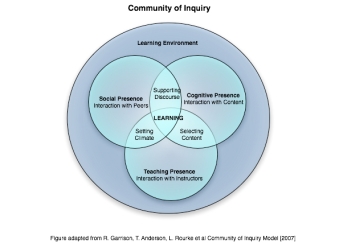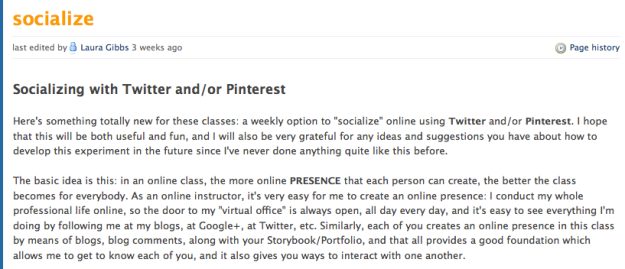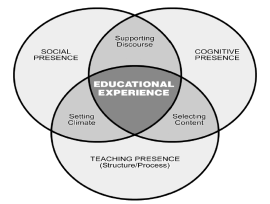Social presence is a significant predictor of course retention and final grade in the college online environment. Two effective interventions are recommended: establishing integrated social and learning communities;… (Liu, Gomez & Len, 2009)
Presence is considered a central concept in online learning. ‘Presence’ in the online course is understood as the ability of people “to project their personal characteristics into the community, thereby presenting themselves to other participants as ‘real people’”. (Garrison, Anderson, & Archer, 2000, p. 89). One way of examining ‘presence’ online is through the Community of Inquiry (CoI) framework, a frequently referenced model that outlines three interdependent dimensions of presence: social, teaching and cognitive. When all three elements interact, it’s then that students are able to experience deep and meaningful learning.
 CoI–is breaking through the social barriers that exist because of the transactional distance between students and instructors (Moore, 1993)…. These human qualities, established through personal sharing, help students develop a sense of trust in and connection with an instructor…foundational for cultivating the social presence needed for a healthy and productive [learning].
CoI–is breaking through the social barriers that exist because of the transactional distance between students and instructors (Moore, 1993)…. These human qualities, established through personal sharing, help students develop a sense of trust in and connection with an instructor…foundational for cultivating the social presence needed for a healthy and productive [learning].
Other bodies of research suggest presence is a key factor to engagement, another metric for predicting student success in online coursework. Presence in this context also considers student perceptions of instructor involvement as a central factor. High levels of engagement, studies indicate, lead to higher levels of student achievement, greater likelihood of graduation, and deeper satisfaction (Oblinger, 2014, p 14).
Presence and Social Media
But describing presence in an online course is vague, slippery—hard to describe. It’s a challenge for instructors to figure out how to make presence happen. What does one do to create social and teaching presence in an online course? This post outlines examples that describe how faculty and instructors use social media to establish presence—that feeling of connectedness among students in online and F2F courses. What’s described here, social media as a vehicle for presence-development, is different however from using social media as a pedagogical tool, which I wrote about in a previous post, How to Use Social Media Platforms to Create Meaningful Learning Assignments. Though there is some overlap. One of the aims of using social media platforms in this context is to bridge the distance gap that exists in online education, to overcome the disconnectedness student can feel when studying online.
Presence in F2F classes: Numerous educators have found that social media tools support a sense of community, or connectedness in face-to-face (F2F) courses as well. One faculty member shares his experience in the Prof Hacker column over at The Chronicle, “Twitter adds to the community spirit of the class and help to sustain student interest across the days and weeks of the semester” (Sample, 2010).
Examples of Instructors Using Social Media
Below are examples of how instructors use social media platforms to create a sense of being ‘there’. Note: the methods described here facilitate informal learning; to foster a learning community. Social media used in structured (or formal) learning activities is used as a method to bring about targeted learning outcomes as mentioned earlier.
1) Twitter
The paper “Tweeting the Night Away: Using Twitter to Enhance Social Presence” describes how the Twitter platform creates a sense of community among students. In 140 characters or less, learners share ideas and resources, ask and answer questions, collaborate on problems of practice, participate in discussions at conferences, webinars, or lectures. A hashtag (a.k.a.the pound sign ‘#’) for a class aggregates all ‘Tweets’ (messages) sent on platform when the hashtag is used as a tag for all class-related messages. For example a professor at Trinity College created a tag #eng685 for his face-to-face English class (Sample, 2010). Hashtags are also used to aggregate tweets on specific topics, e.g. #onlinelearning, #highered.
“Twitter’s just-in-time design allowed students and instructors to engage in sharing, collaboration, brainstorming, problem-solving, and creating. Participants noted that using Twitter for socializing and learning purposes felt more “natural and immediate” than did using a formal learning management system.” (Dunlap & Lowenthal, n.d.)
Examples of how Twitter is used:
- To post news and share resources relevant to the class
- To ask questions and respond with clarifications about the readings
- Professor Sample allows and encourages students to tweet during class, in an attempt to create a “back channel” to class discussion but admits, “This back channel idea has never worked as successfully for me in class as it has at an actual conference” (Sample, 2010).

Screen shot of a current course, ‘Indian Epics’, #ou3043, an online course taught by Professor Gibbs at the University of Oklahoma.
- Tweeting the Night Away: Using Twitter to Enhance Social Presence, Joanna C. Dunlap & Patrick R. Lowenthal
- Practical Advice for Teaching with Twitter, Mark Sample
- How to Start Tweeting, Ryan Cordell
- Using Hashtags on Twitter, Twitter Help Center
2) Pinterest
Pinterest is a digital bulletin board, and holds great potential for education settings. It’s visual, flexible, customizable by using images, and text to create themed boards that can be templates for projects; individual and group—a tool to support instructional activities. Yet Pinterest also has tremendous potential for increasing presence and interactivity. Professor Gibbs is experimenting with Twitter and Pinterest as vehicles for socializing in two of her online courses this semester:

Screen shot from Professor Gibbs’ course web page for students describing how to socialize in Indian Epics and Myth & Folklore undergraduate online courses. Retrieved from http://onlinecourselady.pbworks.com/w/page/83588941/socialize
Gibbs shares links to students’ Pinterest boards on a webpage within the course site on the Pinterest Class Directory. Students can comment on one another’s boards, re-pin to their own board and/or ‘like’ a pin. Students do need sign up for a Pinterest account using an email address.

Screen shot of a student’s Pinterest board ‘Epics of India Portfolio’. Retrieved from http://www.pinterest.com/catherinelesser/epics-of-india-portfolio/
- Socializing with Twitter and/or Pinterest, Laura Gibbs
- Pinterest for Educators? Edutopia
3) Google+ Hangouts/Video Conferencing
Real-time meetings, seminar discussions even watching panel discussions over video conferencing platforms are excellent methods to create a feeling being there and together. I’ve participated in several online courses (MOOCs & closed, small online courses) where the Google+ Hangout platform (or similar) has been used in a variety of ways that do create feeling of being in a learning community. Even if students can’t engage in the active discussion on the platform, Twitter is frequently used as the back channel for questions and discussion. Sessions are usually recorded, then posted for students that can’t participate live.

Screen shot of Google Hangout of a seminar discussion around a class reading with five students and professor of a Massive Open Online Course. Other students’ watching live, asked questions and discussed via Twitter.
- Google+ Hangouts: 6 Practical Uses for Online Education,
- How Educators and Schools Can Make the Most of Google Hangouts
4) Instagram
 Instagram is one of the most popular social media platforms used by high school and college students in North America. It’s similar to Twitter, as the platform uses hashtags, though it’s billed as a photo sharing platform. Yet it has more potential than Twitter since character limit for Instagram captions is 2200, considerably more than Twitter’s 140 limit. Instagram comments have a limit of 240 characters.
Instagram is one of the most popular social media platforms used by high school and college students in North America. It’s similar to Twitter, as the platform uses hashtags, though it’s billed as a photo sharing platform. Yet it has more potential than Twitter since character limit for Instagram captions is 2200, considerably more than Twitter’s 140 limit. Instagram comments have a limit of 240 characters.
I’ve not yet come across examples of educators using Instagram to create social presence for courses, though numerous institutions use Instagram as a marketing vehicle. There is considerable potential in online courses for Instagram as a presence-building tool given its popularity with the younger set—it’s just a matter of time.
- 3 Ways Colleges use Instagram, Ryan Lytle
- Getting Started on Instagram, Instagram Help Center
- How 10 Colleges are Using Instagram, Terry Heick
Closing
Technology is shaping culture. Alternatively, one could say that culture is shaping technology. Whichever viewpoint one takes, social media is central to the change, to the shift in how we communicate, socialize and learn. Educators have an opportunity to help students (and ourselves) blur the lines between informal and formal learning—creating life-long learners.
References:
- CoI Model, Athabasca University
- Garrison, D. R., Anderson, T., & Archer, W. (2000). Critical inquiry in a text-based environment: Computer conferencing in higher education model. The Internet and Higher Education, 2(2-3), 87-105.
- Joyce, K.M. & Brown, A. (2009). Enhancing Social Presence in Online Learning: Mediation Strategies Applied to Social Networking. Online Journal of Distance Learning Administration, vol. 12, no. 4 (Winter)
- Liu, S.Y, Gomez, J. & Leng, C. (2009). Community College Online Course Retention and File Grade: Predictability of Social Presence, Journal of Interactive Online Learning, vol. 8, no 2.
- Oblinger, D. (2014). Designed to Engage. EDUCAUSE Review, vol. 49, no. 5 (September/October 2014)










